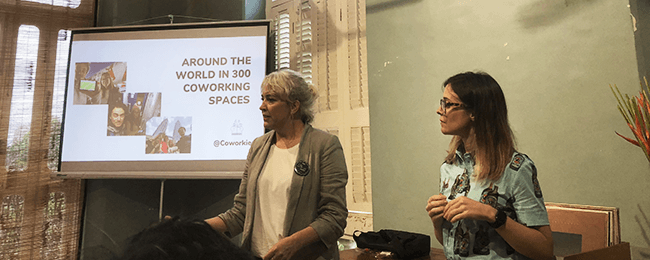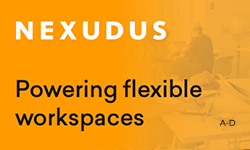How can coworking spaces impact people and cities? After 200,000 km of traveling around the globe our guest author Pauline Roussel summarized some of her key findings in this article.
Pauline Roussel is the co-author of “Around The World in 250 Coworking Spaces”, a coffee table book released in September 2021 together with Dimitar Inchev. Throughout the 352 pages of the book, readers are taken on a unique journey around the world of collaborative workspaces. Find out more on @coworkies.
Can you remember the very first time you came across a coworking space? How did it make you feel? I still vividly recall the day I pushed the doors of a Berlin coworking space I was soon going to become the “Chief Happiness Officer” of. Venturing my way around the 2,000 sqm (20,000 sqft) former warehouse for trabants cars, I immediately felt part of something, which I’d soon learn was called a community.
That same community inspired me and Dimitar Inchev, a member of the space at the time, to dive deeper into one question: what kind of impact coworking spaces have on their communities and their cities? To find out, we started traveling. Around the city of Berlin at first, and then, further and further. Along the way, we soaked all the learnings and reflected on the experiences we got to live while on the road. Below are some of our reflections.
Coworking spaces have the power to change neighborhoods and cities
One of the hidden powers of coworking spaces is their ability to completely change neighborhoods and, to a certain extent, redefine cities. To illustrate this thought, let’s put you to work. Take a map of your city and imagine that the empty map you see now is what it looked prior to the opening of the first coworking space in town. Now type coworking and see how many pins are appearing.
- How many buildings have been renovated?
- How have streets and neighborhoods with coworking spaces in them changed over the years?
To go even further and according to one of deskmag latest’ surveys, coworking spaces have, on average, around 50 members. Add all those members to each and every pin you see on the map and try to picture their impact on neighborhoods around the city?
- They create jobs in and around the space they work from,
- They consume from bars, restaurants and shops around their workplace.

Dimitar and Pauline in Berlin on a train trip to coworking spaces in Poland
Throughout our travels, the positive impact of coworking spaces in neighborhoods and cities is something we’ve witnessed firsthand, especially in places we had the chance to come back to more than once. Cities like London, Berlin, Paris, or even remote areas of Japan or India have completely changed over the years, with more and more opportunities coming to neighborhoods who were previously more lively at times where people were not at work.
As opposed to more ‘traditional offices’ - coworking spaces have more than one purpose. Beyond offering a place to work, they are also hosting events of all kinds during the day and at night, allowing local residents to access more content closer to their homes. Have you ever tried to look for events in coworking spaces around your house? If not, try to have a look. There might be an art exhibition, a movie night or a (beer) yoga class happening soon!
Coworking is “the same dish everyone cooks differently”
Besides their ability to transform and revive neighborhoods, coworking spaces are all quite different from one another. Have you ever walked in a coworking space and felt you’ve experienced the exact same thing in a different one? Probably not.
Let’s compare coworking to a dish and let that dish be a pizza.
If you felt like baking your own pizza today, you’d probably look online for the ingredients you need to make it all happen. You’ll first have to find the recipe that inspires you the most. Then, you’d probably take out all the ingredients you need to make that yummy pizza. Make the dough, put all your ingredients on top, bake it, take it out of the oven and compare it to the picture of the internet recipe you selected? Does it look exactly the same? Difficult to compare its taste but it would be fair to say that the taste might slightly differ, because you might have put more salt, more pepper or you might have even got creative with oregano or chili flakes.
Well, this is coworking.
The recipe and core idea is indeed the same: sharing a place to work.
But the way to ‘do’ coworking always varies from one space to another. Besides the obvious (different buildings calling for different interiors), coworking is a very human-driven business. If you compare coworking A to coworking B and go beyond what you see, the experience you’ll have surely won’t be the same. In coworking A you might be greeted by a community manager who will take you for a tour and tell you all about the space. While in coworking B, you might struggle to find a reception desk or even identify who works for the space, simply because there is no defined reception.
And this is just the tip of the iceberg. Diving deeper into the topic, you might also experience tours differently depending on who is doing it. Is it the founder? A community member? Or maybe you have to book a tour and can’t just randomly pop in.
Take this example and apply it to each and every single aspect of your coworking experience to understand how unique all of those spaces are and how difficult it is to actually compare them to one another. Choosing a coworking space is like choosing a hotel. You might be more sensitive to certain colors or certain smells, or maybe for you location matters more. The fact that there is no right or wrong way to do coworking, makes it so interesting because it means that coworking can work for a vast array of communities.
No, coworking is not just for freelancers and startups
While freelancers and startups were the first target audiences of coworking spaces, the industry has grown a lot since 2005 and today, many communities are thriving and benefiting from it.
Throughout our journey around the world, we realized that coworking spaces are often targeting either a certain audience (parents, people with disabilities) or a certain type of profession (musicians, chefs, makers). Echoing our previous point, it feels like coworking keeps on reaching a broader audience, spreading its positive impact to more people and companies.
Try it out for yourself. Once you are done reading this article, try to look for a coworking space connected to your personal or professional life. It might not be near you but, if you find one that really resonates with your interests or with your work, it might be worth connecting with them and see whether they offer a virtual coworking membership? If not, it might be a good workation destination to pinpoint :)
Many roads lead to the creation of a coworking space
“I’d love to start a coworking space but I have no experience.” A sentence we’ve heard many times while traveling and it is an interesting one. What kind of experience is actually needed to create a coworking space?

Pauline at the 'Ministry of New' in Mumbai
Looking at our data, collected while traveling and while writing our coffee table book it seems like there is no ‘one path’ making a coworking space be more successful than another. People who start coworking spaces come from all walks of life. They were bankers, lawyers, doctors, psychologists, architects, teachers, builders or even engineers, but they all shared one thing in common: the desire to try something new and surround themselves with a community of like-minded people. Through coworking, they are able to experiment and create their own ‘recipe’ , the one that will resonate with their values and beliefs.
And it is those values and beliefs that make members want to be a part of their community or explore other ones that will be more aligned with what they look for.
Next time you enter a coworking space (even if it is yours) do a little exercise: try to put it in perspective with what was shared here and look around you. How is the neighborhood compared to what it was before? How do you experience the space from the moment you push its doors? Is this the right recipe for you? Overall, coworking is an experience for the curious so don’t be shy and keep exploring when you can. And if you feel like sharing your thoughts on the topic with us, come tell us on Instagram.








